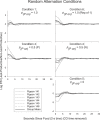Examining the discriminative and strengthening effects of reinforcers in concurrent schedules
- PMID: 21909166
- PMCID: PMC3168889
- DOI: 10.1901/jeab.2011.96-227
Examining the discriminative and strengthening effects of reinforcers in concurrent schedules
Abstract
Reinforcers may increase operant responding via a response-strengthening mechanism whereby the probability of the preceding response increases, or via some discriminative process whereby the response more likely to provide subsequent reinforcement becomes, itself, more likely. We tested these two accounts. Six pigeons responded for food reinforcers in a two-alternative switching-key concurrent schedule. Within a session, equal numbers of reinforcers were arranged for responses to each alternative. Those reinforcers strictly alternated between the two alternatives in half the conditions, and were randomly allocated to the alternatives in half the conditions. We also varied, across conditions, the alternative that became available immediately after a reinforcer. Preference after a single reinforcer always favored the immediately available alternative, regardless of the local probability of a reinforcer on that alternative (0 or 1 in the strictly alternating conditions, .5 in the random conditions). Choice then reflected the local reinforcer probabilities, suggesting some discriminative properties of reinforcement. At a more extended level, successive same-alternative reinforcers from an alternative systematically shifted preference towards that alternative, regardless of which alternative was available immediately after a reinforcer. There was no similar shift when successive reinforcers came from alternating sources. These more temporally extended results may suggest a strengthening function of reinforcement, or an enhanced ability to respond appropriately to "win-stay" contingencies over "win-shift" contingencies.
Keywords: alternation; choice; key peck; pigeon; reinforcer effect; switching-key.
Figures







Similar articles
-
Choosing among multiple alternatives: Relative and overall reinforcer rates.J Exp Anal Behav. 2017 Sep;108(2):204-222. doi: 10.1002/jeab.269. Epub 2017 Jul 31. J Exp Anal Behav. 2017. PMID: 28758210
-
Signaled reinforcement: Effects of signal reliability on choice between signaled and unsignaled alternatives.Behav Processes. 2020 May;174:104088. doi: 10.1016/j.beproc.2020.104088. Epub 2020 Feb 21. Behav Processes. 2020. PMID: 32092454
-
Development and maintenance of choice in a dynamic environment.J Exp Anal Behav. 2010 Sep;94(2):175-95. doi: 10.1901/jeab.2010.94-175. J Exp Anal Behav. 2010. PMID: 21451747 Free PMC article.
-
A model for discriminating reinforcers in time and space.Behav Processes. 2016 Jun;127:62-73. doi: 10.1016/j.beproc.2016.03.010. Epub 2016 Mar 22. Behav Processes. 2016. PMID: 27016156 Review.
-
Conditioned reinforcement and response strength.J Exp Anal Behav. 2010 Mar;93(2):269-89. doi: 10.1901/jeab.2010.93-269. J Exp Anal Behav. 2010. PMID: 20885815 Free PMC article. Review.
Cited by
-
On Multiscaled and Unified.Behav Anal. 2013 Fall;36(2):313-323. doi: 10.1007/BF03392317. Behav Anal. 2013. PMID: 28018042 Free PMC article. No abstract available.
-
Training reinforcement rates, resistance to extinction, and the role of context in reinstatement.Learn Behav. 2016 Mar;44(1):29-48. doi: 10.3758/s13420-015-0188-8. Learn Behav. 2016. PMID: 26139290
References
-
- Cole S, Hainsworth F.R, Kamil A.C, Mercier T, Wolf L.L. Spatial-learning as an adaptation in hummingbirds. Science. 1982;217:655–657. - PubMed
MeSH terms
LinkOut - more resources
Full Text Sources
Miscellaneous

